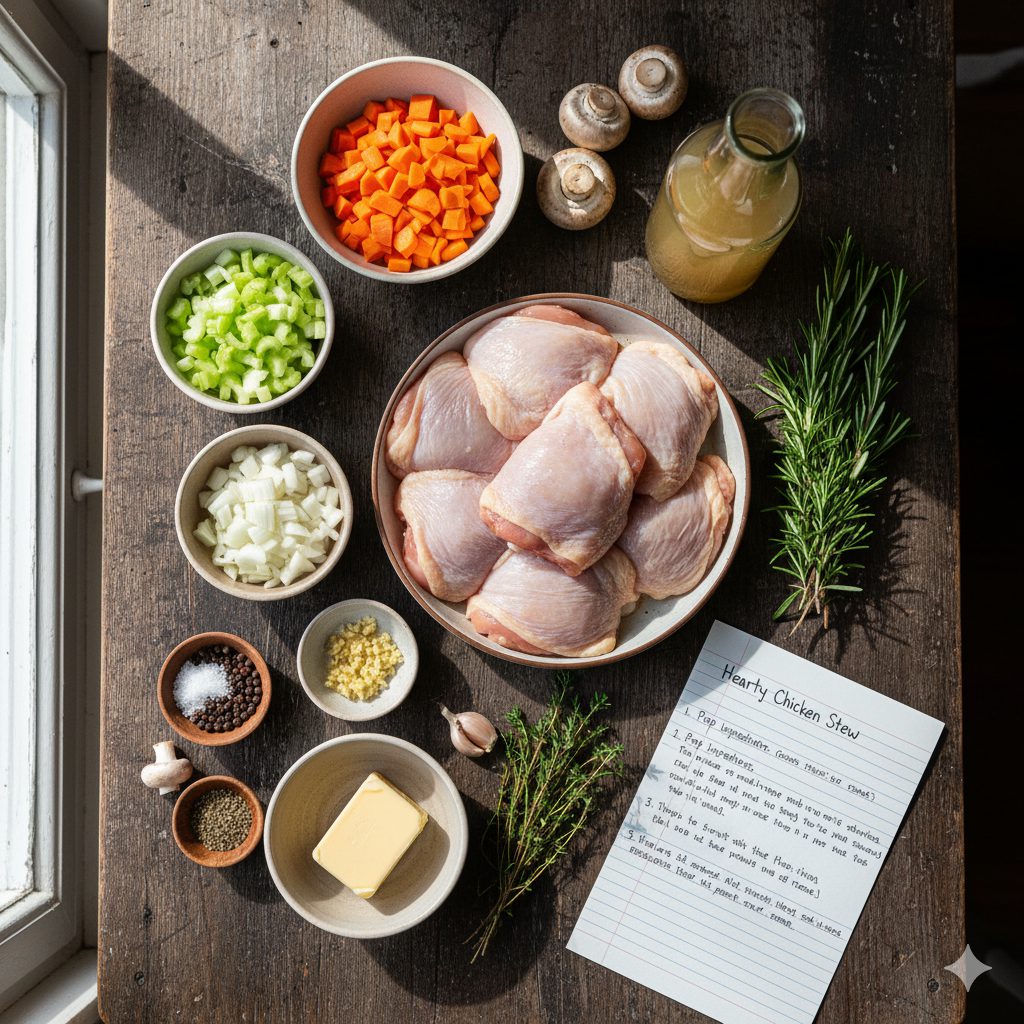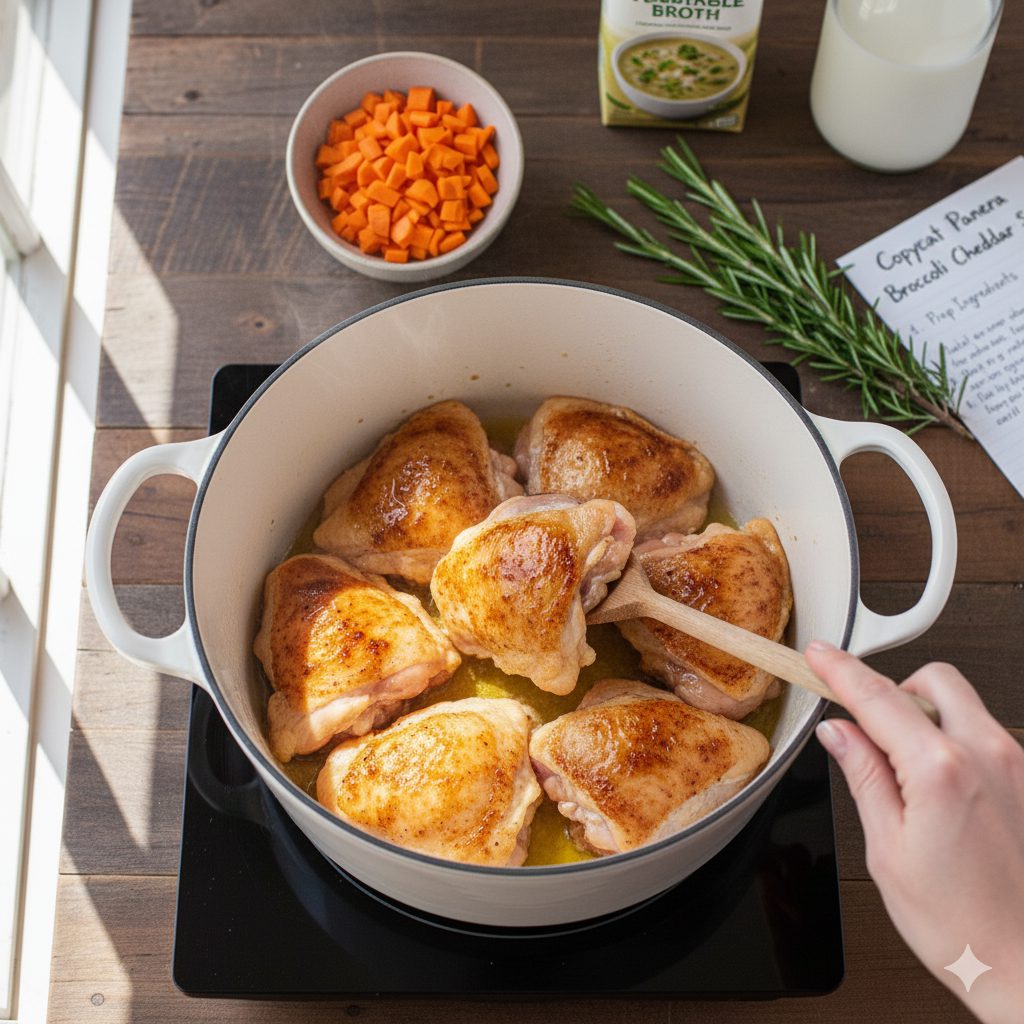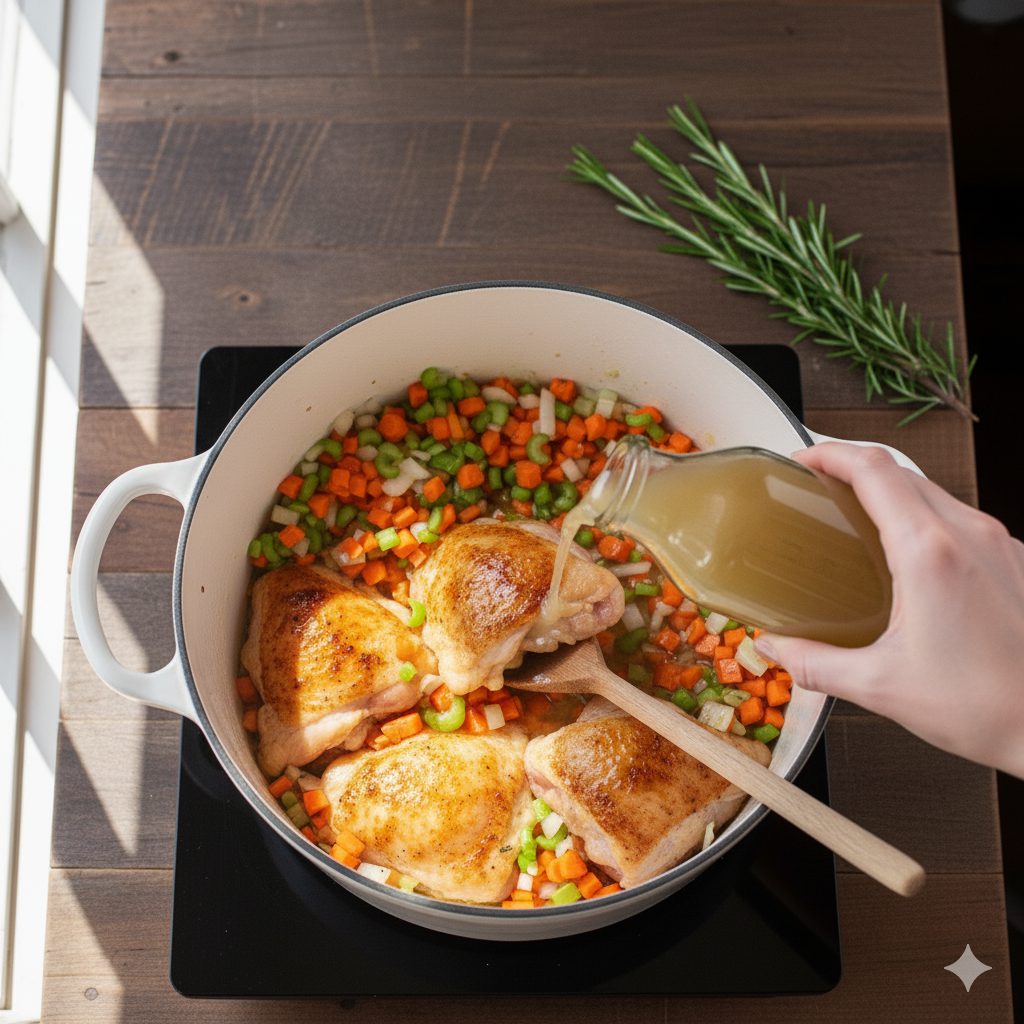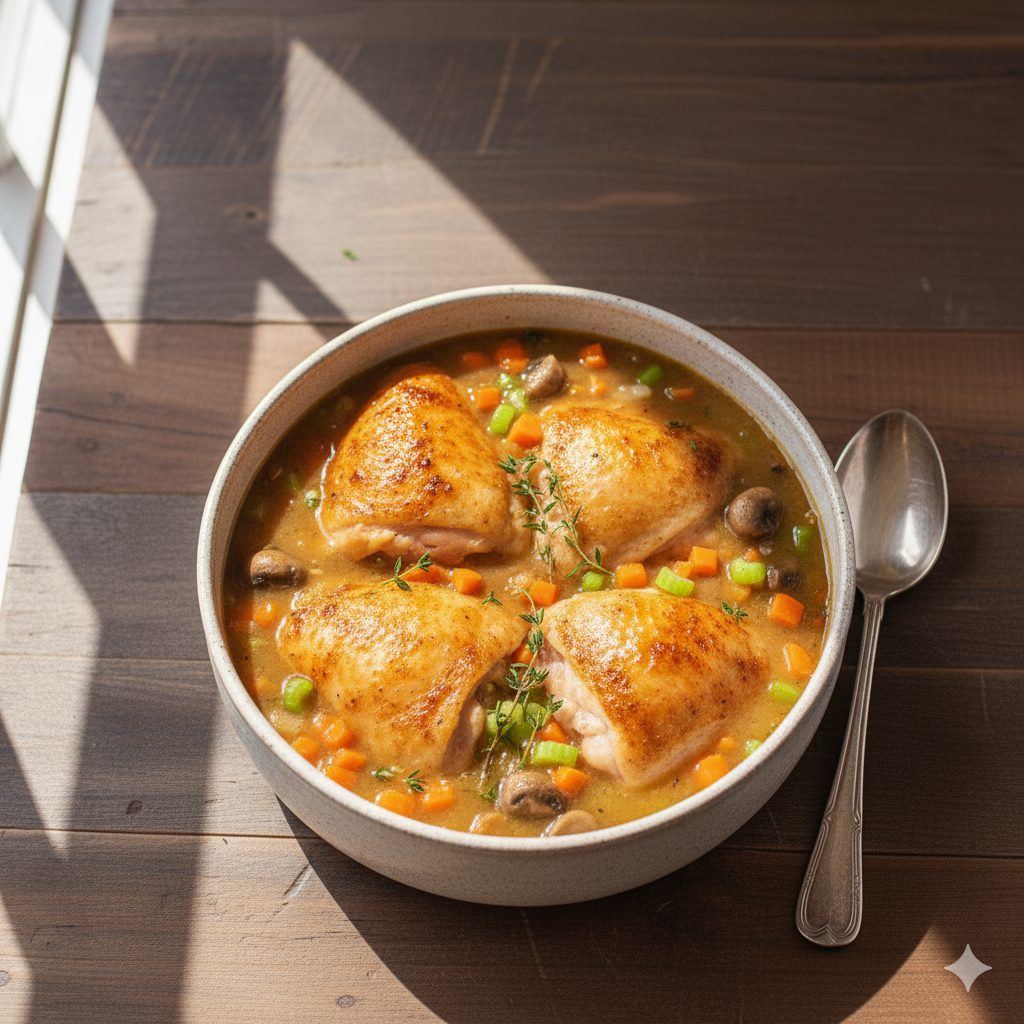
Begin by searing chicken until its edges are savory and golden, then build the base with caramelized onions, garlic, and a bouquet of herbs that deepen the broth as it simmers. Chunky potatoes and sweet carrots join the pot and slowly release starch and natural sugars, turning the liquid into a silky, spoon-coating sauce that feels both nostalgic and indulgent. Every mouthful offers tender meat, soft vegetables, and a rich broth that wraps you in warmth.
This stew is as practical as it is delicious. It shines when cooked low and slow in a heavy pot so flavors have time to mature, yet it adapts easily to a pressure cooker or slow cooker for busy evenings. Swap root vegetables according to the season, stir in a handful of leafy greens near the end for color and nutrition, or mash a few potatoes into the liquid if you want a thicker, heartier texture. Small additions such as a splash of Worcestershire, a pinch of smoked paprika, or a handful of frozen peas stirred in at the finish allow you to personalize the stew without changing the comforting core.
Serve the stew steaming in deep bowls with crusty bread for dipping, ladled over fluffy rice, or beside buttery mashed potatoes. Finish each portion with a scattering of fresh parsley and a generous grind of black pepper; a little lemon zest or a squeeze of lemon at the table brightens the richness if you prefer a fresher note. Leftovers are often even better the next day, making this an excellent recipe for meal prep or for freezing in single portions to reheat on busy nights.
Save this pin to your “Comfort Food” or “One-Pot Meals” board so you always have a go-to, soul-warming dinner at hand. Pin it now — when chilly evenings or hectic weeks arrive, this Chicken Stew will be the comforting, crowd-pleasing recipe you reach for again and again.
CHICKEN STEW RECIPE
Description
Warm, hearty, and effortlessly nourishing, this Chicken Stew is the kind of one-pot meal that turns ordinary nights into cozy occasions. Tender chicken pieces simmer with potatoes, carrots, and aromatic onions in a rich, savory broth scented with thyme and bay leaf. As the stew bubbles gently, vegetables soften and the flavors meld, resulting in a spoonful that’s comfortingly familiar yet layered with depth.
The method is straightforward: brown the chicken to build flavor, sweat the aromatics, deglaze the pan, then add stock and root vegetables and simmer until everything is tender. Small techniques — like adding vegetables in stages, skimming excess fat, or finishing with a splash of lemon — lift the stew from good to memorable. This recipe is flexible: use a slow cooker for hands-off comfort, a pressure cooker to speed things up, or toss in seasonal roots and greens to adapt to what’s in your pantry.
Pin this to your “Comfort Food” board so it’s ready whenever you need a warm, satisfying dinner — simple to make, endlessly adaptable, and always welcome at the table.
Ingredients
Instructions
-
Prep everything first: cut the chicken into bite-sized pieces and pat dry, season lightly with salt and pepper, and dust each piece with a thin coating of all-purpose flour. Peel and dice the onion, mince the garlic, peel and slice the carrots and celery stalks, and cube the potatoes so all ingredients are ready to go before the stove is on.
-
Heat a heavy-bottomed pot and add olive oil or butter. When the fat is hot and shimmering, add the floured chicken in a single layer and let it sear undisturbed until a deep, golden-brown crust forms on the first side; flip and brown the other side. Work in batches if needed so the pan stays hot and each piece develops color, then transfer the browned chicken to a plate.
-
-
Add the sliced carrots and celery to the pot and sauté for 3–4 minutes so they begin to soften and pick up the pan flavors. This step layers sweetness and vegetal depth into the stew before liquid is introduced.
-
Sprinkle about a tablespoon of flour over the softened vegetables and stir for roughly a minute to cook out the raw flour taste and create a light thickening base. Slowly pour in the chicken broth while scraping the bottom of the pot with a wooden spoon to lift the browned bits (fond); whisk or stir briskly to smooth out any lumps so the broth becomes a silky, flavorful backbone for the stew.
-
Nestle the cubed potatoes and the seared chicken back into the pot, add dried thyme and dried rosemary, then bring the mixture to a gentle boil. Reduce to a low simmer, partially cover, and let cook undisturbed until the potatoes are tender and the chicken is cooked through—about 20–30 minutes depending on size.
-
If you prefer a thicker stew, mash a few potato cubes against the pot wall with a spoon and stir to release their starch, or whisk a small flour slurry (1 tbsp flour + 2 tbsp cold water) and stir it in, simmering a few more minutes until the broth coats the spoon.
-
Toss the frozen peas into the stew during the final 2–4 minutes so they warm through but retain color and a touch of bite. Taste and adjust seasoning with salt and black pepper as needed; remove any herb stems and skim any excess fat from the surface for a cleaner finish.
Nutrition Facts
Servings 6
- Amount Per Serving
- Calories 350kcal
- % Daily Value *
- Total Fat 12g19%
- Saturated Fat 4g20%
- Cholesterol 75mg25%
- Sodium 800mg34%
- Potassium 900mg26%
- Total Carbohydrate 30g10%
- Dietary Fiber 5g20%
- Sugars 6g
- Protein 30g60%
* Percent Daily Values are based on a 2,000 calorie diet. Your daily value may be higher or lower depending on your calorie needs.
Note
Chicken Stew Tips and Serving Tricks
There’s something magical about a pot of chicken stew simmering away—it’s rustic, comforting, and nourishing all at once. But behind that cozy bowl lies a few clever tricks that can transform an ordinary stew into a dish worth remembering. From cooking methods to serving ideas, here are some unique tips to take your chicken stew to the next level.
1. Start with a good sear
Always sear your chicken pieces before simmering. This step locks in juices while creating golden bits at the bottom of the pan, which later dissolve into the broth for a deeper, richer flavor. Skipping this step can leave your stew tasting flat.
2. Use a mix of chicken cuts
While boneless breasts are convenient, adding thighs gives the stew a more tender bite and richer taste. A combination of light and dark meat creates a well-rounded, hearty texture.
3. Let the vegetables work for you
Instead of thickening with only flour or cornstarch, allow your stew’s own ingredients to do the job. As the potatoes simmer, mash a few pieces against the side of the pot—their starch naturally blends into the broth, giving it body and a velvety texture without extra thickeners.
4. Season in stages
Salt and pepper should be added gradually, not just at the end. This ensures the flavors develop evenly, and you avoid a bland base or an over-salted finish.
5. Add a fresh finish
Right before serving, lift the flavors with something bright. A quick grate of lemon zest, a squeeze of fresh citrus, or a handful of chopped herbs like parsley or dill can cut through the richness and make the stew taste lighter and more vibrant.
6. Don’t overcrowd your pot
Give your ingredients space to cook properly. Crowding prevents browning and can make your vegetables steam rather than caramelize. A wide Dutch oven is ideal for chicken stew.
7. Creative serving ideas
Instead of just ladling into bowls, try serving your stew over creamy mashed potatoes, fluffy rice, or even buttery egg noodles for a heartier meal. Crusty bread on the side is perfect for soaking up every drop of broth.
8. Refresh when reheating
Chicken stew often deepens in flavor after a night in the fridge, but it can also thicken as it sits. When warming it up, do so slowly over low heat and stir in a bit of extra broth, water, or even a splash of milk to loosen the texture. This simple step revives the stew, making it taste just as comforting as the day it was first cooked.
Serving Tricks
1. Serve over hearty bases
Chicken stew shines when poured over mashed potatoes, buttered noodles, or fluffy rice. These bases soak up the flavorful broth and make the meal extra filling.
2. Pair with warm accompaniments
Instead of serving the stew on its own, offer it alongside warm rolls, garlic bread, or soft dinner biscuits. These sides aren’t just fillers—they soak up the savory broth and turn each serving into a more comforting, complete meal.
3. Add lighter contrasts
Balance the richness with a fresh side salad or serve over cauliflower rice for a lighter, lower-carb option without losing comfort.
4. Finish with garnishes
Brighten bowls with a sprinkle of parsley, grated Parmesan, or a squeeze of lemon juice.
Chicken Stew Tips and Variations
To elevate your chicken stew, start by searing the chicken until golden to lock in flavor and juices. Using a mix of cuts, like thighs for tenderness and breasts for lean meat, creates a balanced and hearty stew.
For exciting variations, try swapping regular potatoes with sweet potatoes or adding parsnips for a subtly sweet, earthy flavor. Toss in fresh greens like spinach, kale, or Swiss chard at the end for a vibrant pop of color and nutrition.You can also experiment with spices such as smoked paprika, nutmeg, or a pinch of chili flakes to add depth and warmth. These simple adjustments make every pot of chicken stew uniquely satisfying.
Serving Suggestions:
Enjoy chicken stew straight from the pot in warm, cozy bowls. Complement it with soft dinner rolls, garlic bread, or a bed of fluffy rice to soak up the savory broth. Sprinkle with fresh herbs or a hint of lemon zest for added freshness, or serve alongside a crisp salad or roasted vegetables for a balanced meal.
Storage & Reheating:
- Refrigerator: keep in an airtight container for 4 days.
- Freezer: Freeze in some portions for 3 months. Thaw it overnight before reheating.
- Reheat: warm it on medium flame and add water if it feels thick.
Final Thoughts:
Chicken stew is more than just a meal—it’s comfort in a bowl, perfect for chilly evenings, family dinners, or whenever you crave something hearty and nourishing. Its beauty lies in its versatility: you can adapt the ingredients to suit your taste, swap vegetables according to the season, or adjust the seasoning for a bolder or milder flavor.Whether served with crusty bread, over rice, or alongside seasonal vegetables, this chicken stew is a recipe that comforts, satisfies, and keeps people coming back for more. Save it to your favorites—it’s a classic you’ll turn to again and again.










